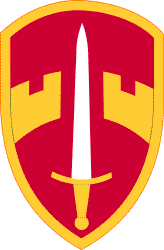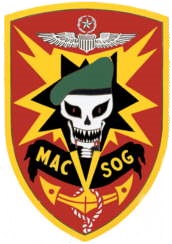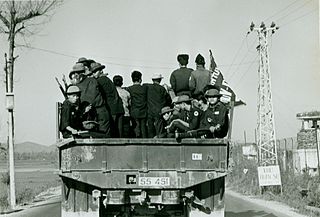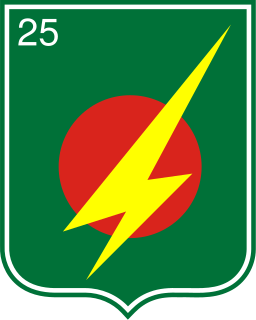
U.S. Military Assistance Command, Vietnam (MACV) was a joint-service command of the United States Department of Defense.

The Civilian Irregular Defense Group program was a program developed by the U.S. government in the Vietnam War to develop South Vietnamese irregular military units from minority populations.

Military Assistance Command, Vietnam – Studies and Observations Group (MACV-SOG) was a highly classified, multi-service United States special operations unit which conducted covert unconventional warfare operations prior to and during the Vietnam War.

The 1st Theater Sustainment Command is a major subordinate unit of US Army Central at Fort Knox, Kentucky.

United States Army Republic of Vietnam (USARV) was a corps-level support command of the United States Army in the Vietnam War.

The Iraq Assistance Group (IAG) was a U.S. military command underneath Multi-National Corps-Iraq that coordinated military transition teams assigned to the Iraqi Security Forces (ISF) including the Iraqi Army, Federal Police, Department of Border Enforcement, Ports of Entry Directorate and provincial police. These teams provide partnership, mentoring and training to assist their ISF partners in achieving full operational effectiveness and facilitating the transition of internal security to Iraqi control. The Iraq Assistance Group itself was a joint command formed from the U.S. Army's 1st Infantry Division and composed of mostly Army soldiers but also including a sizable contingent of sailors, airmen and marines as well as members of foreign militaries.

The South Vietnamese Regional Forces were a component of Army of the Republic of Vietnam (ARVN) territorial forces. Recruited locally they served as full-time province-level defence forces. In 1964, the Regional Forces were integrated into the ARVN and placed under the command of the Joint General Staff.

The South Vietnamese Popular Force was a part-time local militia of the Army of the Republic of Vietnam (ARVN) during the Vietnam War. The South Vietnamese Popular Force mainly protected homes and villages in South Vietnam from attacks by the Viet Cong (VC) and later the People's Army of Vietnam (PAVN).

The Army of the Republic of Vietnam Special Forces were the elite military units of the Army of the Republic of Vietnam (ARVN). Following the establishment of the Republic of Vietnam in October 1955, the Special Forces were formed at Nha Trang in February 1956. During the rule of Ngô Đình Diệm, the Special Forces were run by his brother, Ngô Đình Nhu, until both were assassinated in November 1963 in a coup. The Special Forces were disbanded in 1975 when South Vietnam ceased to exist after the Fall of Saigon.
The Mobile Strike Force Command, or MIKE Force, was a key component of United States Army Special Forces in the Vietnam War. They served with indigenous soldiers selected and trained through the largely minority Civilian Irregular Defense Group (CIDG) and were led by American SF and Australian Army Training Team Vietnam (AATTV) personnel. MIKE Force was a force multiplier, operating what is today called a Foreign Internal Defense mission.

The Vietnamese Rangers, properly known in Vietnamese as the Biệt Động Quân (En:Commando) and commonly known as the ARVN Rangers, were the light infantry of the Army of the Republic of Vietnam. Trained and assisted by American Special Forces and Ranger advisers, the Vietnamese Rangers infiltrated beyond enemy lines in search and destroy missions. Initially trained as a counter-insurgency light infantry force by removing the fourth company each of the existing infantry battalions, they later expanded into a swing force capable of conventional as well as counter-insurgency operations, and were relied on to retake captured regions. Later during Vietnamization the Civilian Irregular Defense Group program was transferred from MACV and integrated as Border Battalions responsible for manning remote outposts in the Central Highlands.

CORDS was a pacification program of the governments of South Vietnam and the United States during the Vietnam War. The program was created on 9 May 1967, and included military and civilian components of both governments. The objective of CORDS was to gain support for the government of South Vietnam from its rural population which was largely under the influence or controlled by the insurgent communist forces of the Viet Cong (VC) and the North Vietnamese People's Army of Vietnam (PAVN).

The Fifth Division of the Army of the Republic of Vietnam (ARVN)—the army of the nation state of South Vietnam that existed from 1955 to 1975—was part of the III Corps that oversaw the region of the country surrounding the capital, Saigon.

The 25th Division of the Army of the Republic of Vietnam (ARVN)—the army of the nation state of South Vietnam that existed from 1955 to 1975—was part of the III Corps that oversaw the region of the country surrounding the capital, Saigon. It was based at Củ Chi Base Camp to the northwest of the city.

The 1959 to 1963 phase of the Vietnam War started after the North Vietnamese had made a firm decision to commit to a military intervention in the guerrilla war in the South Vietnam, a buildup phase began, between the 1959 North Vietnamese decision and the Gulf of Tonkin Incident, which led to a major US escalation of its involvement. Vietnamese communists saw this as a second phase of their revolution, the US now substituting for the French.

During the Cold War in the 1960s, the United States and South Vietnam began a period of gradual escalation and direct intervention referred to as the joint warfare in South Vietnam in the Vietnam War. At the start of the decade, United States aid to South Vietnam consisted largely of supplies with approximately 900 military observers and trainers. After the assassination of both Ngo Dinh Diem and John F. Kennedy close to the end of 1963 and Gulf of Tonkin incident in 1964 and amid continuing political instability in the South, the Lyndon Johnson Administration made a policy commitment to safeguard the South Vietnamese regime directly. The American military forces and other anti-communist SEATO countries increased their support, sending large scale combat forces into South Vietnam; at its height in 1969, slightly more than 400,000 American troops were deployed. The People's Army of Vietnam and the allied Viet Cong fought back, keeping to countryside strongholds while the anti-communist allied forces tended to control the cities. The most notable conflict of this era was the 1968 Tet Offensive, a widespread campaign by the communist forces to attack across all of South Vietnam; while the offensive was largely repelled, it was a strategic success in seeding doubt as to the long-term viability of the South Vietnamese state. This phase of the war lasted until the election of Richard Nixon and the change of U.S. policy to Vietnamization, or ending the direct involvement and phased withdrawal of U.S. combat troops and giving the main combat role back to the South Vietnamese military.

The Viet Cong (VC) insurgency expanded in South Vietnam in 1962. U.S. military personnel flew combat missions and accompanied South Vietnamese soldiers in ground operations to find and defeat the insurgents. Secrecy was the official U.S. policy concerning the extent of U.S. military involvement in South Vietnam. The commander of Military Assistance Command, Vietnam (MACV), General Paul D. Harkins, projected optimism that progress was being made in the war, but that optimism was refuted by the concerns expressed by a large number of more junior officers and civilians. Several prominent magazines, newspapers and politicians in the U.S. questioned the military strategy the U.S. was pursuing in support of the South Vietnamese government of President Ngô Đình Diệm. Diệm created the Strategic Hamlet Program as his top priority to defeat the VC. The program intended to cluster South Vietnam's rural dwellers into defended villages where they would be provided with government social services.
Operation Washington Green was a security and pacification operation during the Vietnam War conducted by the 173rd Airborne Brigade in Bình Định Province from 15 April 1969 to 1 January 1971.

The Joint General Staff (JGS) was a body of senior uniformed leaders in the South Vietnamese military which advised the Ministry of National Defence and the President of South Vietnam.

The 68th Medical Group was constituted on 18 October 1927 in the Regular Army as the 18th Medical Regiment. Redesignated as the 68th Medical Regiment and reorganized as the 68th Medical Group, the organization served in combat in Europe in World War II and in the Republic of Vietnam. During the Cold War, it was stationed at Fort George G. Meade, Maryland from 1954 until its deployment to Vietnam and was reactivated again in Germany, where it served from 1978 into the 1990s.
















